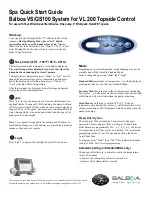
Section 3 | Data Acquisition
©
2023
–
Valeport Ltd
Page | 10
3
Data Acquisition
Hyperion optical sensors are designed for both static monitoring and profiling operations either as
a standalone instrument or as part of a profiling multi sensor instrument.
The optical sensor should be mounted with the window on the front face of the instrument and
therefore, the beam of excitation light directed into the water body to be analysed. During the
synchronised observation period ambient light is measured while the Hyperion LED is off and again
when the LED is on in order to cancel out the ambient light effects.
If very high ambient light levels are encountered, e.g. bright sunlight, in shallow water where there
is a light coloured \ reflective bottom, the receiver may become saturated and return negative
number results. If this happens some form of shading will be required and the sensor not mounted
so it points directly at the bottom.
Valeport can provide an Ambient Light Shield (0901SA7). Please contact Valeport for details.
3.1
Output Rate
The signal output can be configured between 0.5 Hz and 16 Hz (free running) using software
control.
The unit is factory pre-set to the maximum synchronous averaging period (0.5 Hz or 2 secs) in
order to be able to resolve the minimum detection limit.
Fast data rates should only be used w here good signal levels are encountered, otherwise features
may be lost in the background noise. In very low signal conditions, signal:noise ratio issues will,
therefore, limit the maximum vertical speed and resolution when running profiles.
3.2
Operating Modes
Hyperion can operate in a number of modes.
The set-up of these modes uses a macro like format where a command C02 or M16 will set the unit
into a particular mode and configure multiple filter settings appropriately for that mode and update
period.
Other operational modes and filter settings are available - please contact Valeport with your
specific requirements.











































